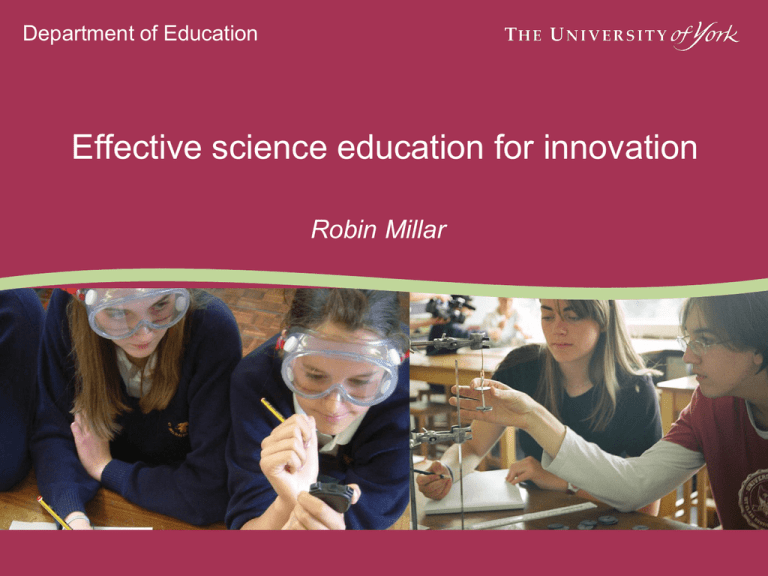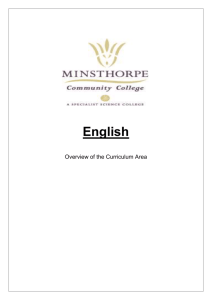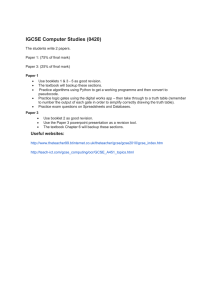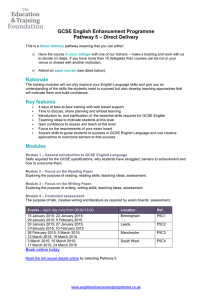Effective science education for innovation Robin Millar Department of Education
advertisement

Department of Education Effective science education for innovation Robin Millar Centre for Innovation and Research in Science Education (CIRSE) • Based in a University Department of Education • Involved in pre-service and in-service education of science teachers (for secondary school) • Developing new approaches to science teaching and learning • To address perceived problems of current practice • Informed by research and scholarship in science education • In collaboration with practising teachers and with scientists working in research and industry Department of Education 2 3 A brief history • Development of a series of ‘context-led’ science courses • 1983: a 1-year chemistry course for 14 year olds to increase interest, and influence subject choices at age 14 • 1985: a two-year GCSE Chemistry course for 15-16 year olds • 1988: a GCSE Science course (B,C,P) with the same approach • 1991ff: A-level courses (for 17-18 year olds), first in Chemistry, then Physics, then Biology • From 2002: Development of an inter-related set of GCSE courses (Twenty First Century Science) designed to address the diversity of students’ interests and aspirations • Centred on a core GCSE Science course with a ‘scientific literacy’ emphasis Department of Education 4 Textbooks for some CIRSE curriculum projects • Available to schools nationally • Schools choose from a list of officially accredited courses • Courses taken annually by: • 2500 - 8250 students (A-level sciences) • ~150 000 students (GCSE Science) Department of Education ‘Context-led’ science courses • Start from contexts in which students are (or might become) interested • Introduce abstract ideas only where they can be seen to be useful • Link science to students’ everyday lives • To questions students ask (or could be stimulated to ask) about the material world Department of Education 5 Why ‘context-led’ science courses? • To improve student engagement with science • All learning depends on getting – and holding – students’ interest • To improve learning by making science ideas seem more ‘worth knowing’ • To help students learn to apply scientific ideas to real situations • To give students a better informed and more accurate image of modern science • How and where science is being used, and developed, today Department of Education 6 From ‘context-based science’ to ‘scientific literacy’ • ‘Context-based science’ • Increasing students’ motivation to learn science as ‘traditionally’ conceived • A ‘scientific literacy’ emphasis • Asks that we review the role of science in the school curriculum What is the contribution of science to a general education? What sort of understanding of science would we like everyone to have? Department of Education 7 8 The primary goal of science education “A central fact about science is that it is actually done by a very small fraction of the population. The total of all scientists and engineers with graduate level qualifications is only a few percent of the whole population of an industrialised country. Thus the primary goal of a general science education cannot be to train this minority who will actually do science.” Ogborn, J. (2004). Science and Technology: What to teach? In M. Michelini (ed.) Quality Development in Teacher Education and Training (pp. 69-84). Udine: Forum. Department of Education 9 Beyond 2000 report • “The science curriculum from 5 to 16 should be seen primarily as a course to enhance general ‘scientific literacy’.” Millar, R. & Osborne, J. (eds.) (1998). Beyond 2000. Science Education for the Future. London: The Nuffield Foundation. Department of Education Scientific literacy “Scientific literacy is the knowledge and understanding of scientific concepts and processes required for personal decision making, participation in civic and cultural affairs, and economic productivity. Scientific literacy entails being able to read with understanding articles about science in the popular press and to engage in social conversation about the validity of the conclusions. A literate citizen should be able to evaluate the quality of scientific information on the basis of its source and the methods used to generate it.” National Research Council (1996). National Science Education Standards, p. 22. Department of Education 10 11 Beyond 2000 report Department of Education • “The science curriculum from 5 to 16 should be seen primarily as a course to enhance general ‘scientific literacy’.” • How can we achieve this, whilst also catering for the needs of future specialists? 12 The ‘dual mandate’ • The school science curriculum has two purposes: to develop the scientific literacy of all students to provide the first stages of a training in science for some students • These require distinctively different approaches Department of Education 13 Previous curriculum model for 15-16 year olds Double Award GCSE Science 20% of curriculum time Counts as 2 GCSE subjects Taken by >80% of students - with <10% doing less (1 GCSE) and <10% doing more (3 GCSEs) Department of Education 14 Proposed new curriculum model GCSE Science 10% curriculum time GCSE Additional Science 10% curriculum time or Emphasis on scientific literacy (the science everyone needs to know) GCSE Additional Applied Science 10% curriculum time for all students for many students Department of Education 15 Twenty First Century Science Core: for all students Department of Education Additional options: for some students 16 Twenty First Century Science GCSE Science Core course for all students With an emphasis on developing students’ scientific literacy Department of Education GCSE Science: The central aim • To provide students with a ‘toolkit’ of ideas and skills that help them to access, interpret and respond to science, as they encounter it in everyday life. • To give students opportunities to practice using these ideas and skills Department of Education 17 So what science do we meet everyday? • An emphasis on health, medicine, environment • Risk and risk factors • Claims about correlations and causes • Issues that involve science and technology, but also go beyond these Department of Education 18 What do you need to deal thoughtfully with this? • Some understanding of major scientific ideas and explanations • Some understanding of science itself: • The methods of scientific enquiry • The nature of scientific knowledge • The interplay between science and society Department of Education 19 What do you need to deal thoughtfully with this? • Some understanding of major scientific ideas and explanations • Some understanding of science itself: • The methods of scientific enquiry • The nature of scientific knowledge • The interplay between science and society Department of Education 20 21 How is it different? • More obvious links to the science you hear or read about, out of school • Some new content, for example: • risk • evaluating claims about correlations and risk factors • the clinical trial • More emphasis on understanding science as a form of knowledge and enquiry • in the context of evaluating scientific knowledge claims • More opportunities to talk, discuss, analyse, and develop arguments • about science • about the applications and implications of science Department of Education What have we learned? • It is possible to make a course with these design features • which teachers find workable, and many find attractive • A ‘scientific literacy’ emphasis leads to higher levels of student engagement with science • as reported by teachers (with supporting evidence) • on the evidence of students’ post-GCSE subject choices (~30% increase in numbers starting AS-level courses in the sciences • Understanding of science ideas not significantly different from students following more ‘traditional’ courses • despite greater emphasis (and time) on ‘ideas about science’ and discussion of issues Department of Education 22 What have we learned? (contd.) • Teachers need considerable support to take on new teaching approaches and methods, such as: • analysis and evaluation of evidence and argument • discussion of issues and implications • We need to develop better ways of assessing ‘scientific literacy’, that encourage good teaching Department of Education 23 Research Curriculum development • Research-informed curriculum development • Drawing on the best-available research evidence, and insights arising from research, when developing new teaching materials and approaches • Integrating this with practitioner knowledge • Curriculum development as ‘knowledge generation’ • “Curriculum development is the process of discovering the detailed aims and objectives rather than starting with them.” (Campbell et al., 1994: 420) • Research evaluation of innovative courses and teaching approaches Department of Education 24 25 Research to inform curriculum development Some examples of recent research in CIRSE: • Primary research: Students’ attitudes to science and to school science (Bennett) The impact of diagnostic assessment on classroom practice, and student learning (Millar) • Research synthesis (Bennett, Lubben and others): The effects of context-based approaches to the teaching of science on understanding and attitudes The nature, use and effects of small-group discussions in science The effects of the use of ICT in science on understanding Department of Education 26 Judith Bennett (2006): Systematic review of the effects of context-based approaches to the teaching of science on understanding and attitudes Department of Education 27 Teaching science in context: main findings • Attitudes to school science almost always improved (7 of 9 studies) • Attitudes to science also improved, but not as much as to school science (7 of 9 studies) • Both boys and girls demonstrated more positive attitudes, with the biggest change being for girls (4 of 4 studies) • Some evidence of improved conceptual understanding (4 of 13 studies); no significant difference (7 of 13 studies) • Some slight increases in numbers taking science subjects (2 of 3 studies) Department of Education 28 Small-group discussions: main findings • Students often struggle to formulate and express coherent arguments. • Explicit teaching about the structure of a good argument, and how to engage in a discussion, lead to more effective learning. • Groups function more purposefully when the stimulus used to promote discussion involves both internal and external conflict, i.e. where a diversity of views and/or understanding are represented within a group (internal conflict) and where an external stimulus presents a group with conflicting views (external conflict). • Single sex groups function more purposefully than mixed sex groups. Department of Education 29 The central challenge for school science education “Science is a demanding activity. Adjusting it to a curriculum appropriate to the population as a whole is a formidable task. Scientific knowledge offers a materialistic worldview which, in its substance, is devoid of humane reference, whatever might be said of its practices and its implications. Science is profoundly successful, on its own terms, and scientific knowledge profoundly authoritative. In consequence, creating scope for the individuality of pupils to come into play is difficult. … these characteristics of science challenge pupils affectively and cognitively. They challenge curriculum developers. It might even be said that they are somewhat at odds with the tenor of modern cultural life.” (Donnelly, 2003: 19) Department of Education 30 The central challenge for school science education • To help students develop, and see the personal value of, an understanding of some key elements of a large body of consensually accepted knowledge • which uses a framework of abstract concepts and ideas • which do not ‘emerge’ from experience, but need to be communicated by teachers and texts • and which demand sustained engagement, attention to detail, careful reasoning and precise use of language • whilst keeping open a ‘space’ for students’ ideas, questions, creativity, imagination …. Department of Education 31 Difficult , but not impossible • To move towards improvement, we need: • Greater clarity, leading to greater consensus, about intended learning outcomes which requires that these be operationalised • in terms of questions and tasks that we would like students to be able to accomplish • and which will therefore provide evidence of successful learning • Support for teachers in implementing teaching programmes that maximise the active mental engagement of students Department of Education





